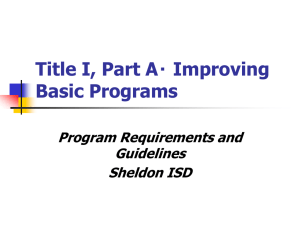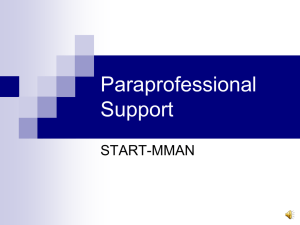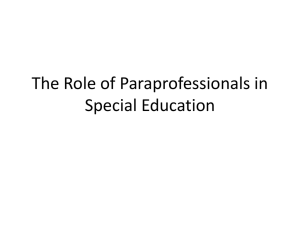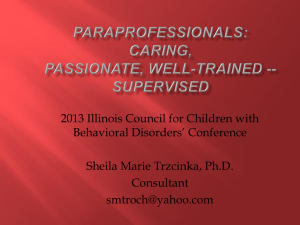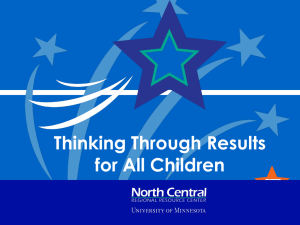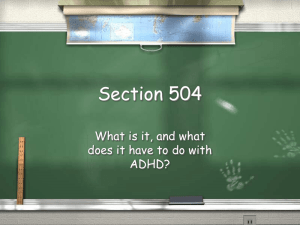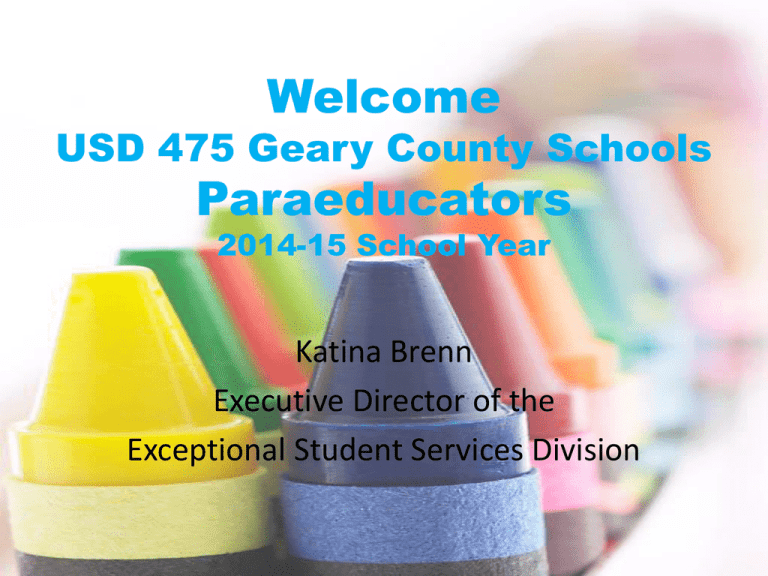
Welcome
USD 475 Geary County Schools
Paraeducators
2014-15 School Year
Katina Brenn
Executive Director of the
Exceptional Student Services Division
ESS Leadership Team
Katina Brenn- Director of Exceptional Student Services
Kathy Beougher- Asst. Director of Exceptional Student Services
Karen Truitt- District Autism Coordinator
Traciann Petite- District Inclusion and Compliance Facilitator
Jennifer Blair- Early Childhood Special Education Coordinator
Stephanie McNemar- Inclusion Facilitator- Seitz Elementary
Freda Felton-Inclusion Facilitator- Ware Elementary
Lindsay Jones- Inclusion Facilitator- Fort Riley Middle School
Ursula Popovich- Inclusion Facilitator- Junction City Middle School
Patricia Dozier- ESS Coordinator- JCHS CAC Campus
Jacinda Kinzie- Inclusion Facilitator- JCHS FSA Campus
Sandy Gray- Transition Coordinator- JCHS
Share Point Resources
PARA
HANDBOOK
Geary County Unified
School District #475
123 N Eisenhower
PO Box 370
Junction City, Kansas 66441
#785-717-4093
Para Handbook Section 1:
Para Work Days/Staff Development
Requirements
•
•
•
•
•
•
•
•
•
Professional Development Record Form (April 17, 2015)
Paraprofessional Work Days Memo
Professional Development Hours Pyramid
ESEA Assessment Requirements
Provenance Learning Solutions Compliance Assessments
Important Assessment Information
Obtaining Professional Development Hours
Infinitec-http://www.myinfinitec.org
CPI Tidbits /CPI Dates
Para Schedule’s
High School: 8:30-3:35
Para’s work: 8:15-3:50 with a 30 min lunch
___________________________________________
Middle Schools: 7:50-2:50
Para’s work: 7:35-3:05 with a 30 min lunch
___________________________________________
Elem Schools: 8:00-3:15
Principal’s split the para staff into 2 schedules
Para’s work: 7:45-3:15 with a 30 min lunch
Or
8:00-3:30 with a 30 min lunch
PARAPROFESSIONAL WORK DAY
PARAPROFESSIONAL WORK DAYS
To:
From:
Re:
Date:
Building Principals, Coordinators, Teachers, Paraprofessionals and Payroll Dept.
Katina Brenn, Executive Director of Exceptional Student Services Department
Paraprofessional Work Days
June 18, 2014
Instructional Paraprofessionals first full day of work will be August 11. The schedule for the day includes
working in their assigned school with their supervising Exceptional Student Services teacher in the morning
and attending the required beginning of the year orientation in the afternoon. The first full day for HI
Interpreters and paraprofessionals assigned to the ARC, FLS, and TLC classrooms will be August 8. The
schedule for the day includes working in their assigned school with their supervising Exceptional Student
Services (ESS) teacher. If Principals have any paraprofessionals not needed because of enrollment, please
contact The ESS Director.
Paraprofessionals who have worked for USD 475 as a paraprofessional for 3 full years or less are required to
have 20 hours of professional development (or 2 hours for every month of employment). Paraprofessionals
who have worked for USD 475 as a paraprofessional for 4 consecutive years or more are required to have 10
hours of staff development (or 1 hour for every month of employment). This is regardless of the number of
hours per day that they work). District salary reimbursement is dependent on their ability to complete the
required amount of professional development hours required. Two of the hours each year must be Orientation
which is:
August 11 - 1:30-3:30 Para Orientation. For all paraprofessionals orientation will be at Junction City
Middle School Auditorium (Paraprofessionals who are hired later must attend a district level
paraprofessional orientation.
Kansas Department of Education is asking that Paraprofessionals participate in staff development
with their supervising teachers. Staff development days should be building days if possible,
determined by their building level administrator. The paraprofessional handbook offers
paraprofessionals multiple opportunities for obtaining staff development hours to include but are not
limited to 1 college credit = 20 hours, Provenances module = 1 hour, Infinitec modules = the amount
of time of the module, and a book review evaluation process. Please consult the paraprofessional
handbook for additional options. The paraprofessional handbook can be found under the
paraprofessional resources link on the district’s Exceptional Student Services (ESS) Department’s
share point site.
Once paraprofessionals attain their 10 or 20 hours of staff development, they will not be paid to
work any further staff dev. days unless principals request paraprofessionals to work for specific
reasons. Requests should be made to the Exceptional Student Services (ESS) department office.
PARAPROFESSIONALS DO NOT WORK: Flexible Professional Development days or Parent/Teacher
Conf. Days
ELEMENTARY PARAPROFESSIONALS: Can work the K-5 Plan days as determined by their Principal.
To:
From:
Re:
Date:
Special Education Paraprofessionals and Administrators
Katina Brenn, Director of Exceptional Student Services Division
The Elementary and Secondary Education Act Requirements
August 1, 2013
The Elementary and Secondary Education Act - includes requirements for teaching aides which includes
special education paraprofessionals who assist with instruction in reading, math and writing. This law
applies to Title I buildings. Our district is choosing to apply this law district wide (EC-12).
Paraprofessionals must:
1) Obtain college hours equivalent to an Associate’s degree – (48 hours) OR
2) Obtain an Associate’s or higher degree.
The alternative to taking college hours is:
Paraprofessionals must pass an assessment in reading, writing and math within 90 days of
employment.
To get set up to complete study modules and/or schedule the assessment contact Nicole Nutter at
717-4093
USD #475 has purchased the Master Teacher site which is accessible from any computer and will assist
you in:
preparing for the academic assessment (which is mentioned above) AND
creating a “transcript” of courses which can be used for in-service hours
Information about accessing this network is on the attached page.
Completion of one course will equate to one hour of staff development if you choose to do this. You will
be asked to print a “transcript” of the modules you have completed by April 17, 2014.
SUGGESTED RULES AND RELEVANT
ASSESSMENT INFORMATION
• Accommodations for person with disabilities, visual difficulties,
physical handicaps, etc. should be arranged for paraeducators,
provided the accommodations do not include assistance in
answering the questions or a change in the assessment.
• Breaks should be permitted for emergencies only. If a break is
necessary, the para must show the supervisor the portion of the test
completed and log off. The para will then resume the assessment up
on return.
• Only the internet window with the assessment should be open. The
supervisor should monitor each screen to make certain the para
follows this rule.
SUGGESTED RULES AND RELEVANT
ASSESSMENT INFORMATION
• The supervisor will answer only questions about assessing and using
the assessment program.
• There should be no talking among the paras during the assessment.
• Calculators/cell phones/notes are not permitted. Scratch paper
should be provided.
• This assessment must be completed by the 90th day of employment.
You may not return to work until the assessment has been
completed.
Obtaining Staff Development Hours
• College Hours – One or more credit hours = 20
hours of in-service
• Read a book (education relevant) – 150 pages = 3
hours
• Watch a video (education relevant) – In-service
time = time of video
• My http://www.myinfinitec.org -Infinitec Website
on line modules
• You must have permission from your administrator
to work more than the required Staff
Development hours.
Obtaining Professional Development Hours
LEA Determined – In-service Requirement
Hold a current Kansas teaching license
Note: Taking the ESEA
test does not accrue
professional
Development hours
Related Service license – eligible for Categorical Aid
OTA, PTA, and LPN
10 Hours – In-service Requirement
Special education para for USD 475 for more than 3
years – years must be consecutive and recent
(as archived in the Personnel Database)
20 Hours- In-service Required
3 consecutive years or less & recent years experience as
a special education para in Kansas
Due no later than April 17th
Para Handbook Section 2: Roles and
Responsibilities
•
•
•
•
•
•
•
•
•
•
•
•
•
•
•
•
•
Information from KSDE Concerning Paraprofessionals Kansas Regulations
Paraprofessional Competencies
Appreciating Diversity
Confidentiality
Importance of teamwork
A Law to Protect the Privacy of Student records
Ethical Guidelines for Paraprofessionals
Teacher and Para Roles in Managing Behavior
The ABC’s of Behavior
Principals of Motivation/Reinforcements
How to manage behavior when it occurs
Ethical Considerations in Behavior Management
Supporting Teachers’ Instruction
Assessing Student Performance
Supporting Instruction in Content Area Classes
Accommodations and Modifications
Characteristics of Effective Paraprofessionals
Role Clarity
• Teacher has the overall responsibility for the program
• Paraeducator works under the supervision of the
teacher –know the boundaries of your role
• Teacher needs to be primary contact person with the
parents with regards to questions about child’s
behavior, program planning, etc.
• Paraeducator should not make independent decisions
about what the family or the child needs:
– Consult with the teacher
– Pass on families’ questions and requests to the teacher
Role Clarification
Teacher/Professional Roles
– Overall Program Planning (overseeing, IEP
goals and objectives, addressing standards,
lesson planning, prescribing, managing the
instructional environment)
– Instruction (based on unit plans, lesson
plans, IEPs, remedial literacy plans, 504 plans,
other individualized plans)
– Assessment (Collecting, coordinating, and
interpreting information about the student
including current levels of functioning,
determination of disability, reporting student
progress)
– Collaborating (consulting with other
professional personnel, meeting coordinating,
communication)
Paraeducator Roles
Implement instruction in various environments,
based on lesson plans provided by the teacher
Reinforce learning with individuals or small
groups
Assist individual students- personal care, mobility
Assist with observations/data recording/charting
Assist with ongoing behavior management
Participate in building level duties as assigned by
building administrator
Assist in data collection
Maintain and operate instructional equipment
Help develop schedules
Team participation
– Managing Paraeducators
20
Kansas Regulations Regarding Paraprofessionals
The following statements are from the Kansas Special
Education Regulations. They say that at paraprofessional……
• Cannot be solely responsible for special education instruction or related
services.
• Cannot select or give formal, standardized tests or interpret any results
• Cannot select, program, or prescribe educational activities or materials
without supervision* and guidance of a teacher. Teachers do all initial
planning and introduction of new material.
• Cannot be solely responsible for preparing lesson plans or initiating
original instruction.
• Must have direct supervision* & involvement from a professional to
implement a student’s IEP.
• Cannot be employed in place of a certified special education
professional.
• Cannot be a substitute teacher unless the paraprofessional has the
appropriate certification.
• Cannot be enrolled as an elementary or secondary student.
• Cannot perform nursing procedures or give medications without
appropriate supervision* from an approved health care
professional.
*Supervision- The professional the paraprofessional is assigned to
must meet Kansas’s certification requirements. When the assigned
teacher is not present, a designated principal or teacher may supervise
the paraprofessional. Supervision time for instructional
paraprofessionals shall be determined by the supervising teacher and
paraprofessional and based on the students’ needs.
Emergency Safety Interventions (ESI)
Emergency Safety Interventions = Seclusion and Restraint
ESI= All Staff & All Students
Guidelines for seclusion and restraint are now Kansas
Regulations
Resources, regulations, and more information can be
found at this website
http://ksdetasn.org/cms/index.php/esi-resources
Definitions
• K.A.R. 91-42-1(c) defines an emergency safety intervention
(ESI) as “the use of seclusion or physical restraint when a
student presents an immediate danger to self or others.”
• Physical Restraint-Bodily force used to substantially limit a
student’s movement. The term does not include physical
escort.
• Physical Escort-The temporary touching or holding of the
hand, wrist, arm, shoulder, or back of a student who is
acting out for the purpose of inducing the student to walk
to a safe location.
Emergency Safety Interventions (ESI)
A school employee should use physical restraint on a child with a disability only if
the child's behavior presents an imminent risk of harm or the child is involved in
an altercation. Except to intercede in an altercation, each school employee
applying physical restraint should use a method of physical restraint in which the
employee has received training and should apply the physical restraint in a
manner that is proportionate to the circumstances and to the child's size and age
and the severity of the child's behavior.
"Physical restraint" means bodily force used to substantially limit a person's
movement, except that consensual, solicited, or unintentional contact and
contact to provide comfort, assistance, or instruction shall not be deemed to be
physical restraint.
"Imminent risk of harm" means an immediate and impending threat of a person
causing substantial physical injury to self or others. Violent action that is
destructive of property may involve a substantial risk of injury to a person.
Reporting to Kansas
• Administrators report to the state on a quarterly
basis the details of any seclusion and/or restraint
• Each building is responsible for keeping a log of
details including: student ID, date, time, duration,
description of ESI, and parent contact that was
made
Reporting to Parents
• Parents must be contacted verbally by the end of
the school day whenever physical restraint or
seclusion are used (just like with a head injury)
• After the verbal contact, parents must be
contacted in writing within 48 hours
What Does this mean in practice?
Immediate danger to self or others means:
• You would need to be able to prove that
you were
– in fear of physical danger
– in fear that others where in physical danger
or
– in fear that the student physically
endangering themselves
Do not place your hands on
a student unless they are
going to harm themselves
or others.
Training
• USD 475 supports and provides training
for verbal de-escalation and restraint
using the CPI program (Crisis
Prevention Intervention). The
philosophy of CPI and the state of
Kansas support the Care, Welfare,
Safety, and Security of staff and
students as a primary concern.
DO
Don’t
Remain Calm
Over react
Be aware of the environment
Issue Ultimatums
Isolate the situation
Freeze
Enforce Limits
Be threatening
Respect personal Space
Enter into a power struggle
Listen
Involve an audience
Be supportive
Take it personally
To determine availability or register for
classes by contacting Nicole Nutter at
(785)717-4093. Class size is limited.
CPI Tidbits
The CPI Supportive Stance:
– Standing outside the personal space bubble
– Turned at a 90º angle
– Stay a leg length away from the person you are working with.
Keys to setting limits
– Be clear and Concise
• Give 2 choices and 2 consequences
– Be reasonable and fair
– Make sure your consequences are enforceable
Rational Detachment:
• The ability to stay in control of ones own behavior and not
take the acting out behavior personally
• Behavior is learned and serves a purpose.
Physical acting-out situations can be
prevented with verbal de-escalation and
physical restraint and/or seclusion is to be
used as a LAST RESORT and only when
the student is in IMMEDIATE DANGER of
hurting themselves or others.
Managing Behaviors and Enhancing Social
Interactions of Student
•
Use age-appropriate language, tone of voice, and reinforcement procedures.
•
Implement teacher-developed behavior plans and techniques that adhere to the
laws, regulations, and procedural safeguards concerning the management of
student behaviors.
•
Demonstrate effective strategies for the management of student behaviors.
•
Implement teacher-developed strategies and techniques that enhance social skill
development in children and youth.
•
Assist teachers and other professionals in modifying the learning environment to
manage behavior.
•
Facilitate the development of peer interactions and friendships for students with
disabilities in classroom, school, and community settings.
•
Monitor and assist children and youth in non-academic learning environments
(i.e., lunchrooms, study halls, playgrounds, and buses).
The ABC’s of Behavior
Reasons for Misbehavior
• Students don’t know teacher expectations.
• Students are unaware of when/how often they’re behaving
inappropriately.
• They don’t know what appropriate behavior is.
• Student may need attention.
• Students may feel powerless, so they create their own
power
The ABC’s of Behavior
A = Antecedent—What preceded or triggered the behavior?
(Develop an understanding of why the behavior occurs.)
B = Behavior—What happened?
C = Consequences—What does the student get out of the behavior?
Examples:
• A = Student leans back in chair.
• B = Student falls over backward.
• C = Peers laugh and student gains attention, or student is injured.
• A = Student is having difficulty reading fluently.
• B = Student refuses to read and gets angry and throws book.
• C = Staff assist and encourage student, provide alternative reading
strategies, or student is sent to the office for discipline.
How To Manage Behavior When It Occurs
Ignore behaviors
Criteria for ignoring behaviors: Ask yourself
• Can you teach?
• Can the student learn?
• Can his/her classmates learn?
• Is the behavior not likely to escalate?
Use nonverbal communication
• Proximity (standing near a student)
• Eye contact
• Gestures (i.e., fingers to lips, nods
• Move your attention away from student
Use verbal communication
• Tell the entire class/group what you expect.
• Give private, quiet redirective to student
• talk to the student privately or create an “illusion of privacy”
• quietly tell student what you expect
• say, “thank you”
• If necessary, give a choice involving a consequence-Consequences must be discussed and
sanctioned by the supervising teacher ahead of time.
Ethical Considerations in Behavior Management
• Behavior management should be viewed as an opportunity for teaching
and not an opportunity for punishment.
• Avoid embarrassing students and offer suggestions in private in the form
of constructive criticism.
• Never engage in a power struggle. Strive for win/win.
• Don’t touch students who are upset, and don’t hesitate to get help from
another teacher if you need it.
Do not place your hands on a student unless they are going to harm
themselves or others.
• Keep your supervising teacher informed.
Confidentiality is extremely important
when working with students
• Keep student information private.
• Don’t speak about students to friends, family, or to or in front of
other students.
• Don’t speak about students to other teachers except on a need-toknow basis.
• If anyone in the school or community asks you for specific
information about a student’s disability, refer them to the
supervising teacher.
• Don’t point our or label children in public.
• Be careful not to distort, exaggerate or confuse information.
• Never use student information as gossip or a joke.
• Focus comments on student strengths and be positive.
A Law To Protect the Privacy of Student Records
The Family Educational Rights & Privacy Act (FERPA)
(FERPA):
• Protects the privacy of parents & students
• Requires that every school district have a written policy, explaining
standards for keeping educational records confidential
• A school district receiving federal funds may lose those funds if it discloses
personally identifiable information in a student’s education records
without the proper consent
Those who may access records without explicit written consent of parents:
• Teachers or other personnel responsible for the design, preparation, and
delivery of education and related services
• Personnel who are responsible for the health, safety, and welfare of a
student
• Paraprofessionals may access educational records through the classroom
teacher and administration, as the local school district permit.
Confidentiality Video
http://www.myinfinitec.org/online-classroom#videoTop
Rehearsed Responses to Requests for Confidential Information
Possible Request
Possible Responses
“I heard you’re working at the school... Is that
3rd grade teacher as mean as everyone says?”
“I’m an employee at the school now, I can’t
talk about my colleagues that way.” OR
“Employees aren’t allowed to talk about one
another outside of school, sorry.”
“Who’s the funny looking kid that flaps his
hands all the time?”
“Student information is confidential to
everyone but his parents and teachers.” OR
“Sorry, I can’t talk about kids outside of
school.”
“What’s the scoop on Gail… I heard her
husband…?”
“Gail’s my fellow employee as well as my
friend now, I can’t discuss her private life.”
“What’s wrong with Suzanna?”
“Student information is protected by law. I’d
be breaking the law if I spoke about any
student outside of school.”
“I heard Jason is doing better with that new
special ed teacher.”
“Jason’s progress is confidential. It’s not okay
for me to discuss it.”
“Is Tanya in the special reading class?”
“Placement of students is a confidential
matter. We’re not allowed to speak about
How are the services you
provide determined?
Step 1
Determine the specific area of
exceptionality based on the
evaluation data
Step 2
Determine what the student’s
areas of strengths and weaknesses
as it pertains to the
exceptionality area
Step 3
Determine the goal(s) in the
weakness or strength areas as it
pertains to the identified
exceptionality that the team will
work toward during the annual IEP
time frame.
Step 4
Determine what specialized
instruction is required to make
progress on the identified goal(s).
Step 5
Determine where the specialized
instruction will take place.
Step 6
Determine the amount of time it will
take to administer the specialized
instruction.
– When does the instruction or behaviors occur?
(math, reading, writing, or behavior goal)
– If the specialized instruction occurs in the general
education setting the amount of time can not exceed
the time that instruction occurs in the schedule.
Paraprofessional Competencies:
General Knowledge and Values
•
Awareness of the legal rights of children and youth with exceptional learning
needs and their parents in educational settings.
•
Understanding of individual learning styles and environmental factors that impact
teaching and learning processes.
•
Understanding of the differences among the roles and responsibilities of
professionals, paraprofessionals, and other support personnel.
•
Basic knowledge of special education processes, procedures, and regulations.
•
Awareness of and respect for social, cultural, linguistic, religious, economic, and
ability differences in students and their families.
•
Understanding of the similarities and differences among the cognitive,
communicative, physical, social, emotional, and behavioral needs of children and
youth with and without exceptional needs.
Communicating and Collaborating with Teachers and
Other Professionals
• Follow teacher instructions and implement team decisions.
•
Interact effectively with and demonstrate respect for the views,
rights, and contributions of parents, teachers, and other school
personnel.
• Contribute relevant, objective information to teachers and other
school professionals to facilitate planning, problem solving, and
decision-making processes across all relevant settings.
• Participate as a member of an instructional team to plan and
organize learning experiences for students.
• Participate in team meetings to assist in the development of
Individual Education (IEPs) for students.
The Characteristics of Effective Para
•
•
•
•
•
•
•
•
Lifelong learner
Good interpersonal skills
A positive attitude
A desire for self-improvement
Self-confidence
Patience
Empathy
Concern for children
Demonstrate Professional & Ethical
Work Behaviors
• Recognize that the supervisor has the ultimate responsibility for
instruction and management of the learning environment.
• Engage only in activities that are delegated to them by the
supervisor
• Follow directions of the supervisor
• Refer concerns about the children, parents, other team members to
the supervisor.
• Communicate child’s progress or concerns with parents or others
only as directed to do so by the supervisor.
• Maintain a high level of competence and integrity.
• Respect the dignity, privacy, human and legal rights of all children,
their families, and staff members
• Refrain from engaging in discriminatory practices based on
children/families disability, race, sex, language, cultural background,
and religion.
Develop Healthy Professional
Relationship with Parents
• Personal vs Professional Relationship
Be aware of the thin line between the two
• Know that friendship with parents:
-needs to be maintained outside the school
-may be personally fulfilling for both parties but
not always effective for the child’s program
• Exercise professionalism and separate your personal
feelings from your work.
• Be an advocate for families but don’t step on other
peoples’ toes.
• Keep teacher in the loop!!
Foster independence among students
& families
• When students become dependent on you –their families
too!
With students:
• Use “wait time” to allow the student to follow teacher
directions independently before stepping into assist
• Give students opportunities to practice on their own
• Support only when needed
• Do things with instead of for the individual.
• Let students choose between acceptable options
• “Moves on” to assist other students needing help once the
support is given.
• Help students learn self-confidence, self-reliance and
achieve as much autonomy as possible
Participating in Professional and Ethical Practices
• Maintain confidentiality of individual students and their families.
• Perform assigned responsibilities under the supervision of teachers in a
manner consistent with professional and ethical guidelines established by
the district, agency, state, or professional organization.
• Assist teachers and other professionals in protecting the civil, legal, and
human rights of children, youth, and their parents.
• Perform tasks that are within an appropriate range of responsibilities for
paraprofessionals.
• Do Not communicate with parents about programming or issues that may
occur. Be sure to direct them your supervisor or administrator.
• Participate in on-going staff development and self-evaluation activities,
and apply constructive feedback to practices within the educational
setting.
• Participate with administrators, consultants, and/or other professionals in
designing and implementing comprehensive professional development
activities for paraprofessionals.
Appreciating Diversity
• Today’s public schools are made up of a diverse group of people. Students
and staff are different from each other in many ways: age, gender,
ethnicity, economic background, religion, lifestyle, values, etc.
• School personnel are expected to have an attitude of acceptance and
appreciation of diversity.
• Staff who take an active interest in understanding the ways their students
are different will be better able to understand those students’ behavior
and, thus, interact with them in ways that will help them learn.
• Having a positive attitude toward diversity means not ignoring differences
and not holding negative attitudes about differences.
• Negative attitudes can be expressed in many ways, two of which are
stereotyping and labeling. Stereotyping is assuming that all people within
a group are the same in some way.
• Another way prejudices are perpetuated is through labeling, which means
referring to an individual by some characteristic, instead of referring to the
person first, then to the disability (i.e., “Person First Language” – for
example, “person with a disability
Importance of Teamwork
Paraprofessional knowledge & skills + Supportive working
environment = satisfied, effective paraprofessional &
improved student learning
•
•
•
•
•
Paraprofessionals’ teamwork responsibilities
Take an active role in your success
Show a positive, cooperative attitude about assigned tasks
Seek out training and supervision in conducting new tasks
Participate in frequent meetings with the supervising
teacher
• Seek information about students and instruction
• Provide the teacher with information about students
Assessing Student Performance
“Assessing student performance” means gathering information about a student and
making a determination about him or her. The main types of assessment that paras
may be involved in.
Standardized Tests
Standardized tests are always given in the same way, using the same instructions, and
materials, and the same scoring methods. Formal standardized tests, are done by
someone who is highly trained and experienced with the test. For less formal testing
situations, for example teacher-developed standardized tests they give repeatedly,
paraprofessionals can be primarily responsible for the activity.
Behavioral Checklists
Behavioral checklists categorize and list specific behaviors. The person completing the
checklist simply checks off whether or not the student is able to perform that specific
behavior.
Direct Observation
Another way to gather information about students is to observe them and record
information about your observations in a systematic fashion. The written information
that reflects what you observed is called “data,” and it can be used to assist with
instructional decisions about the student.
Supporting Instruction in Content-Area Classes
• Paraprofessionals can help carry out and support
interventions the teacher designs.
Examples include:
• highlighting textbooks
• being or training a class note taker
• maintaining a class notebook with assignments,
handouts, materials, etc.
• preparing adapted materials for students
• prompting students to make correct responses
• training a peer partner to assist the student
• providing follow-up instruction
During follow-up instruction, the paraprofessionals can:
• Provide additional instruction
• Follow the basic format of effective instruction:
1) I Do It. 2) We Do It. 3) You Do It.
During small group instruction, the paraprofessionals can:
• Use effective instruction.
• Gain students’ attention
• Review necessary pre-skills
• State goal of the lesson
• “I Do It. We Do It. You Do It.”
• Review the critical lesson content
• State the content of the next lesson
Accommodations and Modifications
Accommodations do not alter the curriculum.
They are supports or services provided to help a student access
the curriculum and validly demonstrate learning.
What are accommodations?
An accommodation is an adaptation that results in the student
with a disability accomplishing the same goals and objectives as
the non-disabled students, and does not fundamentally alter the
general education program.
An accommodation…
changes the conditions by which a student with a disability
accomplishes the same task as the non-disabled student.
Accommodations…
are used to minimize the impact of a disability and circumvent
deficiencies in specific academic areas.
Modifications alter the curriculum.
Modifications change the content and performance expectations for
what a student should learn.
What are modifications?
A modification is an adaptation that results in the student with a
disability accomplishing different goals and objectives as non-disabled
students and fundamentally alters the general education program.
A modification…
alters the task in a way that the student is able to accomplish a
different, perhaps related task assigned to the non-disabled peers.
Modifications…
are used to remediate deficiencies in specific academic areas by
bringing the goals and objectives of the curriculum in closer alignment
with a student’s present levels of educational performance.
Para’s role with modifications and
accommodations:
• Participate in on-going communication with teacher
before making any changes in student’s instruction
• Clarify modifications with teacher before class, not in
front of students or peers
• Communicate modifications or accommodations to the
student in private
• Establish on-going modifications or accommodations
with the teacher.
• Paraprofessionals should check with the supervising
teacher to discuss ideas before making any changes in
student’s instruction.
The Paraeducator’s Role in Adapting
Curriculum & Instruction
• To follow written plans and oral directions!
• Note: It is NOT the paraeducator’s ethical
responsibility to plan or design modifications
or adaptations – only to carry them out!
Educational Support Staff Handbook
Take a second look
• Job Descriptions
• Geary County USD 475 Classified Employee Handbook
–
–
–
–
–
–
–
–
–
–
–
–
–
–
5.3 Leaves & Absences
6.1 Work Schedule/Attendance
6.2 Overtime
6.4 Breaks
6.5 Attendance
7,5 Relationships with Students
7.7 Staff-Community Relations
7.8 Confidentiality
7.12 Dress Code
8.8 Evaluations
8.25 Telephone & Cell Phone Use
8.26 Computer Guidelines
11.1 Child Abuse Reporting
13.3 Reporting Accidents
Katina Brenn
Executive Director of
Exceptional Student Services
Educational Support Staff HR Handbook,
504 Training & Universal Precautions
Section 504 and Title II
Federal Laws--Disability
Americans
with
Disabilities
Act of 1990-Commerce
Clause
Legislation
Section 504
of the
Rehabilitation
Act of 1973-Spending
Clause
Legislation
Individuals with
Disabilities
Education Act-Federally Funded
Education Program
It is the policy of the Geary County USD #475 to
provide a free and appropriate public education
(FAPE) to each qualified student with a disability
within its jurisdiction, regardless of the nature or
severity of the disability. Consequently, it is the
intent of the District to identify and evaluate
qualified students with disabilities within the
meaning of Section 504 of the Rehabilitation Act
and Title II of the Americans with Disabilities Act
who are in need of accommodations or services,
including related services, to participate in District
programs on an equal basis with the students
without disabilities.
What are the School District's
Responsibilities?
The Section 504 regulations require the school & district to:
• Annually attempt to identify and locate all children with disabilities
(Child Find)
• Provide a "free and appropriate public education"
• Ensure that students with disabilities are educated with nondisabled students to the maximum extent appropriate
• Establish nondiscriminatory evaluation and placement procedures
• Establish procedural safeguards
• Ensure students with disabilities the equal opportunity to
participate in nonacademic and extracurricular services and
activities.
Procedures for handling requests for
Section 504
Requests initiated by district staff:
Students who are in need or are believed to be in
need of services under Section 504 and Title II shall be
referred for evaluation. Staff can initiate a request by
contacting the Building based Section 504 and Title II
Coordinator
Requests initiated by Parents/guardians
Requests for Section 504 and Title II
accommodations or services may be requested
verbally or submitted in writing to Building based
Section 504 and Title II Coordinator
Are Section 504 and Special Education
the same?
No.
• Section 504 is a civil rights law that protects a broad
range of students with disabilities from discrimination
on the basis on their handicapping conditions.
• No federal funding is provided to districts to
implement Section 504.
• It is the responsibility of the general education
program to ensure compliance and funding.
• The protections of Section 504 apply to special
education students.
What is a 504 Plan?
A 504 Plan is a written document detailing the services
and accommodations to be provided. The plan should
include:
• A description of the disability
• The major life activity limited
• The basis for determining the disability and its
educational impact
• Necessary accommodations
• Placement in the least restrictive environment
• A review or re-evaluation date
• 504 Team members' names
What are accommodations?
• Accommodations are program adjustments
made to remove disability-related barriers to
a student's full participation in school,
including nonacademic and extracurricular
activities, such as field trips, athletics, and
assemblies.
• Accommodations are made in order to
provide a student equal access to learning
and equal opportunity to demonstrate what
he or she knows.
• Accommodations should not alter or lower
the standards of the coursework or
standards required for participation in
extracurricular activities.
Universal Precautions Training
If you would like to watch the video on Universal
Precautions go to your My Infinitec website and
under the on-line classroom tab there is a resource
labeled Commonly Required Presentations. You
will find the full presentation.
WWW.MYINFINITEC.ORG
Most employees working in school or rehabilitation settings do
not have regular contact with body fluids as part of their jobs.
However, some employees may have risk for exposure to
bloodborne illnesses based on their job tasks. For example,
performing tasks such CPR or first aid, assisting individuals with
toileting or other personal care, and handling physically
aggressive individuals may increase the risk of exposure.
Employees can reduce their risk by practicing Universal
Precautions.
Universal Precautions are the practice of treating
everyone as if they are infected with a bloodborne
illness and taking necessary precautions at all times.
The Universal Precautions system is based on using
Personal Protective Equipment (for example, gloves)
and following procedures for handling, cleaning, and
disposing of contaminated materials and hand
washing.
You can reduce your workplace risk for exposure to
bloodborne illnesses by:
Anticipating and preventing exposure to blood and other
body fluids whenever possible
Covering your own non-intact skin at all times
Using appropriate Personal Protective Equipment
In school and rehabilitation settings, the most
commonly used Personal Protective Equipment is
gloves. You must use gloves any time you expect
hand contact with blood or other body fluids. Latex
gloves are best, but employees with latex allergies
should use a non-latex alternative.
In spite of following Universal Precautions, you may
have an “exposure incident” at work. An exposure
incident is any contact of non-intact skin (for example,
cuts or rashes) or mucous membranes (for example,
the eyes, nose, or mouth) with blood or other
potentially infectious body fluids. An example of an
exposure incident is another person’s blood splashing
into an open sore on your hand.
When an exposure incident occurs:
Wash the exposed area immediately with soap and
hot water (or eye wash if the eye is affected)
Complete appropriate paperwork (see your Building
Exposure Control Plan)
Follow procedures for medical evaluation and followup.
Don’t Forget the Sharepoint Resources
Sign In
Para
Resources
Questions?

